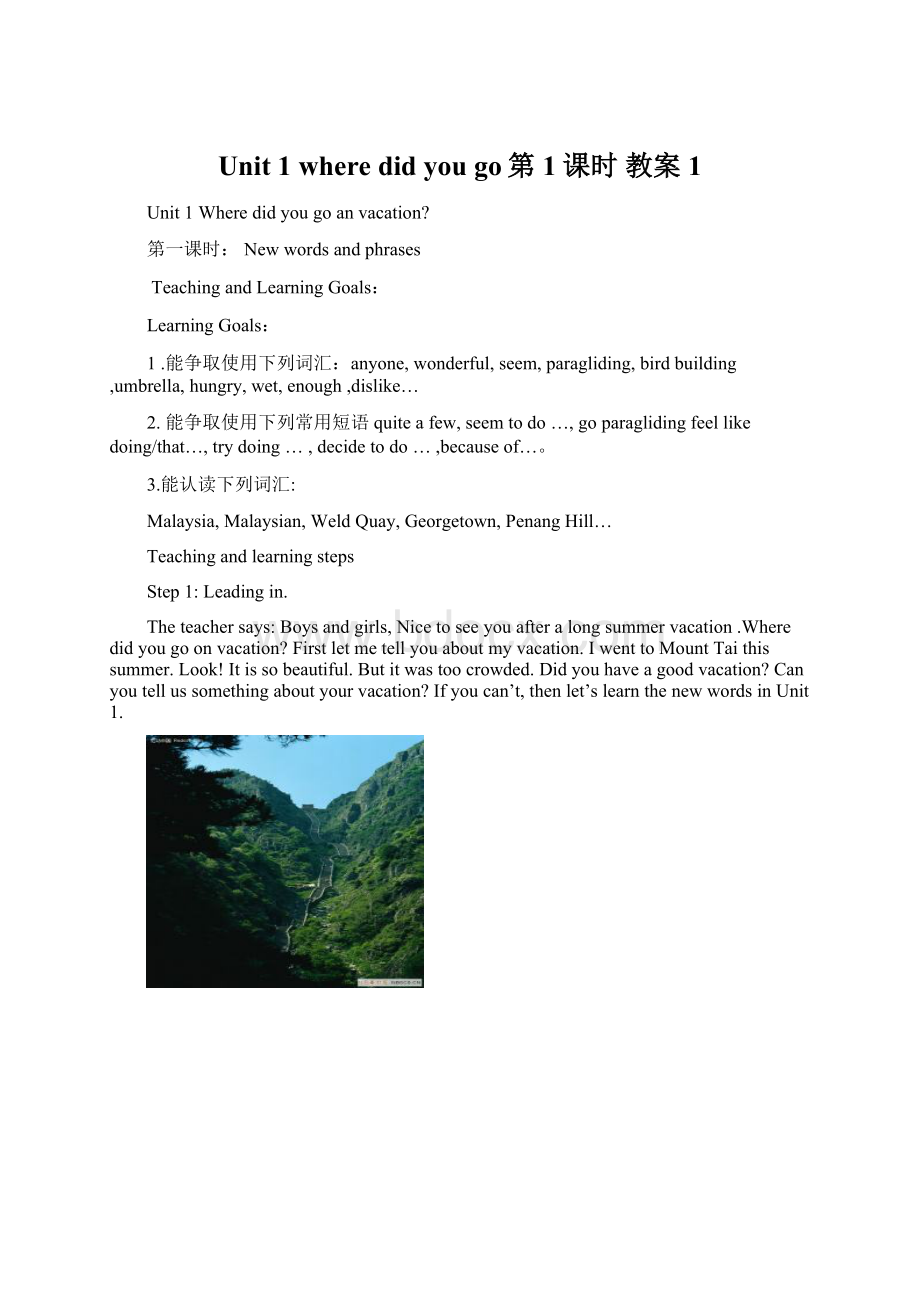Unit 1 where did you go第1课时 教案1.docx
《Unit 1 where did you go第1课时 教案1.docx》由会员分享,可在线阅读,更多相关《Unit 1 where did you go第1课时 教案1.docx(14页珍藏版)》请在冰豆网上搜索。

Unit1wheredidyougo第1课时教案1
Unit1Wheredidyougoanvacation?
第一课时:
Newwordsandphrases
TeachingandLearningGoals:
LearningGoals:
1.能争取使用下列词汇:
anyone,wonderful,seem,paragliding,birdbuilding,umbrella,hungry,wet,enough,dislike…
2.能争取使用下列常用短语quiteafew,seemtodo…,goparaglidingfeellikedoing/that…,trydoing…,decidetodo…,becauseof…。
3.能认读下列词汇:
Malaysia,Malaysian,WeldQuay,Georgetown,PenangHill…
Teachingandlearningsteps
Step1:
Leadingin.
Theteachersays:
Boysandgirls,Nicetoseeyouafteralongsummervacation.Wheredidyougoonvacation?
Firstletmetellyouaboutmyvacation.IwenttoMountTaithissummer.Look!
Itissobeautiful.Butitwastoocrowded.Didyouhaveagoodvacation?
Canyoutellussomethingaboutyourvacation?
Ifyoucan’t,thenlet’slearnthenewwordsinUnit1.
Step2:
LearntoreadthewordsonP121-122
1.Studentsmanagetoreadthewordsusingthephoneticsbythemselvesandmarkthedifficultwords.2.EspeciallyReadthedifficultwordsingroups.
3.Getoneortwomiddle-levelstudentstoreadallthewords.Askthegoodstudentstocorrectthewrongpronunciations.Ifnecessary,theteachercorrectsthem.
4.Readafterthetape
5.Readaloudandtheteacherwalksaroundtoseewhetherstudentshaveanyquestions.
(设计意图:
该步骤能有效培养学生个人识读单词的学习习惯,这是学习单词的重要一步;能培养学生自主、探究和合作学习的能力。
首先学生自己根据音标识读单词,并标出识读时有困难的单词。
接着两人一组或以小组为单位解决遇到的困难。
然后找一俩个同学读单词,请好学生先纠正,还有问题,教师再更正。
最后让学生跟录音读。
该环节只会读即可。
课堂上学习较快的学生会读100%,学习慢的学生会读80%,学习慢的学生会读60%就算过关,降低识读难度,提高全体学生积极性。
鼓励没过关的学生课前课后努力赶上。
)
Step3:
MemorizethewordsonP121-122
一、Rememberthewordsbylookingatthepicturesaboutplaces.
Malaysian.马来西亚
Malaysianadj.马来西亚的
n.马来西亚人
1.MalaysiansarefromMalaysia.
Georgetown乔治市
WeldQuay海墘(滨城)
2.WeldQuayisareallyoldplaceinGeorgetown.
PenangHill槟城山
3.YoucantakethetraintoPenangHill.
CentralPark中央公园
4.Therearequiteafew(相当多)peopleinCentralPark.
HuangguoshuWaterfall黄果树瀑布
5.HuangguoshuWaterfallisinGuizhou.
HongKong香港
6.HongKongseemswonderful(精彩的).
Tian’anmenSquare天安门广场
7.TiananmenSquareisverybeautiful.
thePalaceMuseum故宫博物院
8.ThePalaceMuseumhasmanyoldbuildings(房子).
二、Rememberthewordsbylookingatthepicturesaboutanimals.
hen母鸡
Pig猪duck鸭
9.Theheniswaitingfor(等待)thepigandtheduck,maybesheishungry(饥饿的),too.
三、Rememberthewordsbylookingatthepicturesaboutthings.
umbrella雨伞
bicycle自行车
10.Theumbrellasarewet(湿的),butthebicyclebelow(在…下面)themisdry.
paragliding滑翔伞运动
/88
bird鸟
11.Ifeltlike(感觉)IwasabirdwhenItried(尝试)paragliding.
diary日记
12.Idislike(不喜欢)others’readingmydiaries.
四、Rememberthewordsbyconversion(转换)、complexwords(合成)andderivative(派生)
1.转换
①Ifyoucan’ttryyourbestforthefirsttime,youcanhaveatryforthesecondtime.
②HewonderswhataretheSevenWondersintheworld.
③Theduckisverycutenow,butsoonitwillbeBeijingduck.
④Don’tdislikehishobbies,everyonehashislikesanddislikes.⑤⑥
2.合成
some+one→someone
some+thing→something
some+body→somebody
some+where→somewhere
Youcanalsoremembertheminthisway:
(某)someone(人)
(任何anybody(人)
(每一)everything(事)
(没有)nowhere(地)
3.派生
wonder+fulwonderful
my+selfmyself
build+ingbuilding
trade+(e)rtrader
dis+likedislike
五、Rememberthewordsbymakingavocabularylist.
Wordsaboutplaces
Chinesemeaning
Englishwords
1.中央公园
2.马来西亚
3.滨城
4.槟城山
5.乔治市
6.香港
7.天安门广场
8.故宫博物院
9.黄果树瀑布
Wordsaboutanimals
Chinesemeaning
Englishwords
1.鸡
2.鸭
3.猪
4.鸟
Wordsaboutthings
Chinesemeaning
Englishwords
1.滑翔伞运动
2.自行车
3.日记
4.雨伞
(设计意图:
本部分的设计重点是教会学生,运用不同的方法记住单词。
本课表地名的生词比较多,重点运用图片的帮助加深印象;对于一部分抽象的词,嵌入到句子中,形成有意义的意群来帮助记忆。
而对于复合不定代词则运用complexwords(合成)构词法,以图表的形式展现出来,清晰明了,简单实用。
最后以词汇表的形式进行归纳,再次形成图片记忆输入大脑中。
)
Step4:
Consolidationofthewords
六、Rememberthephasebymatchingitselfwithitsmeaning.
1.waitforthetrain相当多的照片
2.feellikeabird决定尝试
3.ridebicycles感觉像只鸟
4.quiteafewphotos骑自行车
5.becauseofthebadweather等火车
6.decidetotry由于坏天气
7.tryparagliding尝试滑翔伞运动
(设计意图:
语块记忆即关注此的搭配(collocations)是一种有效的记忆短语的方式。
)
七、Rememberwordsbylookingatsemanticmap.
RememberthewordsbytheirChinese.
1.如同_________2.想知道_________
(设计意图:
用汉语意思记单词,常常用来记抽象意义的单词,不提倡用该法记。
)
Step5:
Consolidatethewordsandphrases
AskthestudentstoreadthewordsandphrasesandtheirChinese.CovertheEnglishwordsandphrases,lookattheChineseandsaytheEnglishforthem.Writedownthewordstheyhaven’tgrasped.
(设计意图:
此环节为巩固单词。
这一环节有少部分的学生往往不达标,需要利用自习课或课余的时间让小组长跟踪检查,尽量能让全部学生顺利过关。
)
Readthestoryandtrytotranslateit
1.Askthestudentstoreadthestory,andunderlinethenewwords.
2.TranslatethestoryintoChineseingroupsofsix.
3.Readthestoryfluentlybythemselves.
Iliketraveling.IwenttomanyplacesinChina,suchasBeijing,HongKongandGuizhou.IsawTiananmenSquare,thePalaceMuseumandHuangguoshuWaterfall.
Ithinktheywerewonderful.
Lastsummervacation,IwenttoMalaysiaforvacation.Forthefirstday,Itriedparaglidingonthebeach.IfeltlikeIwasabird.Itwassoexciting.AlsoIrodeabicycletoGeorgetown.ThereweremanyoldbuildingsinWeldQuay.Theywereinteresting.
Forthesecondday,IwenttoPenangHill.Ifoundafarmerlivethere.Hekeptapig,somehens,someducksandsomebirds.Itookatraintothetopafterwaitinganhourforit,butitrainedhard.IgotwetbecauseIdidn’thaveanumbrella.AndIcouldn’tseeanythingbelow.Ididn’thaveenoughmoney,soIwasveryhungryandcold.Idislikeditverymuch.
我喜欢旅游,我去过中国的很多地方,例如北京,香港,贵州。
我看了天安门广场,故宫以及黄果树瀑布。
我认为他们很精彩。
去年暑假,我去马来西亚度假。
第一天,我在海滩上尝试了滑翔伞运动,感觉就像鸟一样,非常振奋人心。
而且我也骑自行车去了乔治市,在滨城有很多古老的房子,非常有趣。
第二天,我去了槟城山,在哪儿我发现了一位农民,他养了一只猪,一些母鸡,一些鸭子和一些鸟。
在等了一个小时的火车之后,我乘坐火车到达了山顶。
但是雨下得很大,我浑身都湿透了,因为我没有带雨伞。
山下的东西什么都看不到。
我没有带足够的钱,因此是又饿又冷,我很不喜欢。
(设计意图:
在学生基本掌握单个单词的基础上,教师把一个单元的生词编成一段逻辑性强的短文,让学生学习单词有了语境,在语境中了解词汇的意义和词汇的表意功能,这为学生学习、实践和运用英语创造了条件,有助于学生有效记忆和使用英语词汇。
)
Step6Mindmap思维导图(选用)
1.Getthestudentstoreadthemindmapandfillinthemindmapaccordingtothearticle,theycandiscussingroups.
2.Retellthestoryaccordingtothemindmap.
新增思维导图.jpeg
(设计意图:
把故事用思维导图的形式呈现,既新鲜又实用,能很好的帮助学生把故事串成一个整体。
这样既巩固了新单词又锻炼了学生在语境中理解和记忆单词的能力。
)
Step7当堂检测
一、根据括号中的汉语提示写单词,完成句子。
1.Todayitisverycoldandthetemperatureiseight________(在…下面)zero.
2.Kevindidn’thavean_______(雨伞)sohewaswet.
3.Alicecaneatahorsenowbecausesheisvery_________(饥饿的).
4.I________(想知道)howhegotthere.
5.Thereisnot________(足够的)moneyinmybag.Ican’tbuythatwatch.
参考答案:
1.below2.umbrella3.hungry4.wonder5.enough
二、用所给单词的适当形式填空。
1.Hedecided__________(look)forajobinBeijing.
2.Hedislikes__________(do)housework.
3.Therearemoreandmoretall_______(build)inourcity.
4.Therearemany__________(different)betweenBritishEnglishandAmericanEnglish.
5.Youshouldtry__________(work)ashardasyoucan.
参考答案:
1.tolook2.doing3.buildings4.differences5.towork
教学反思
亮点:
此次教案我认为亮点主要有以下三点:
一是利用图片记单词的环节中我把本单元的单词首先进行了分组,具体是地名类的,动物类的和事物类的以及不定代词类的,然后再把前三类的毫无关系的名词进行了有机组合,构成了有趣又有意义的句子,再配以精美的图片,使人过目不忘。
不但如此,又能把无法用图片表达的抽象词汇嵌入到这些句子中,很好的规避了零散记忆的弊端。
二是把复合不定代词以与众不同的方式呈现在学生面前,不仅有英语更有汉语的意思包含其中,全面、简洁又清晰明了,利于学生省时高效地完成记忆任务。
三是本着学以致用的原则,采用了暑期研修时刚刚学到的思维导图的技术,以更简单明了的方式帮助学生快速抓住故事的核心内容,依然有着良好的效果。
不足之处:
由于设计的环节比较多,需要紧锣密鼓的进行,否则就有可能完不成,个别环节有走过场的感觉,部分学生跟不上老师的节奏,掌握情况不太好。
使用建议:
让这堂课“活“起来的法宝就是采用小组合作学习的方式。
无论是在读的环节,还是在识记的阶段,鼓励学生在小组内外开展合作竞争是非常有效的。
既能培养学生的参与意识,竞争意识,又能培养团队意识,可谓一举多得。